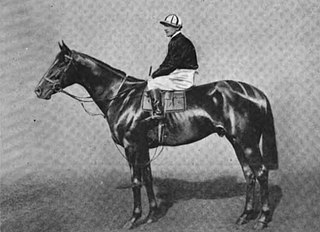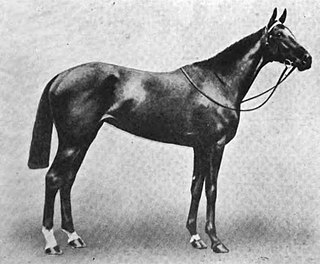 W
WBachelor's Double was an Irish-bred Thoroughbred racehorse that raced in Ireland and Britain and was a successful sire in the early 20th century. He won the Irish Derby as a three-year-old and also won the City and Suburban Handicap in 1910 and the Kempton Jubilee in 1911. Retired to stud in 1912, he sired the 1921 Epsom Oaks winner Love in Idleness and the inaugural Prix de l'Arc de Triomphe winner Comrade. He died in 1931 in Ireland.
 W
WBroomstick (1901–1931) was a Thoroughbred race horse whose most important win was in the 1904 Travers Stakes. After retirement, he became one of the great sires in American racing history, leading the North American sire list in 1913, 1914 and 1915. He was inducted into the National Museum of Racing and Hall of Fame in 1956.
 W
WCharlebelle (1917–1931) was a British Thoroughbred racehorse and broodmare that won the 1920 Epsom Oaks.
 W
WDiadem (1914–1931) was a British Thoroughbred racehorse who won the 1000 Guineas in 1917. She went on to become a top sprinter, recording two victories in both the King's Stand Stakes and the July Cup. In total she won 24 of her 39 races. Diadem was bred and owned by Edgar Vincent, 1st Viscount D'Abernon, and trained by George Lambton. The Diadem Stakes at Ascot Racecourse was named after her.
 W
WDurbar was a French racehorse. Although not the best of his generation in France he proved too good for the leading British colts in the 1914 Epsom Derby, which he won by three lengths. His pedigree was controversial, with the British authorities not recognising him as a Thoroughbred. His racing career was ended by the outbreak of the First World War.
 W
WFifinella (1913–1931) was a British Thoroughbred racehorse and broodmare. In a career that lasted from 1915 until 1917 she ran seven times and won four races. She was the highest-rated British two-year-old of either sex in 1915 and went on to greater success the following season. As a three-year-old in 1916 she won the Derby and Oaks both of which were run that year at Newmarket. She was the sixth and most recent filly to win the Derby.
 W
WMahubah (1910–1931) was an American bred Thoroughbred racemare that was noted for producing the outstanding racehorse, Man o' War.
 W
WPhalaris was a British bred Thoroughbred racehorse, later a Leading sire in Great Britain and Ireland and a Leading broodmare sire in Great Britain & Ireland. He appears in the sireline of all racehorses which were winners of more than $10 million, as well as all yearlings that were auctioned for more than $7.5 million.
 W
WPretty Polly, was an outstanding Irish bred Thoroughbred racehorse and an outstanding broodmare. She won fifteen consecutive races and was only the fifth filly to win the British Fillies Triple Crown since its inception in 1814.
 W
WTiffin was a British Thoroughbred racehorse and broodmare, who was undefeated in a career of eight races. Tiffin won five races in 1928 including the National Breeders' Produce Stakes at Sandown Park and the Cheveley Park Stakes at Newmarket and was the highest-rated British two-year-old of either sex. Her three-year-old season was disrupted by illness and injury, but she won all three of her starts, proving herself the year's best sprinter with wins in the July Cup at Newmarket and the King George Stakes at Goodwood. At her peak she was regarded as one of the fastest racehorses in the world. At the end of her racing career she was retired to stud where she produced one foal before dying in 1931.
 W
WWinkipop (1907–1931) was a British Thoroughbred racehorse that won the 1910 1,000 Guineas Stakes and Coronation Stakes. She raced briefly at age four and was retired from racing in 1911. As a broodmare, she produced the good racers Plymstock and Blink before she was exported to the United States in 1927. Winkipop died in 1931 at the Mereworth Stud near Lexington, Kentucky.